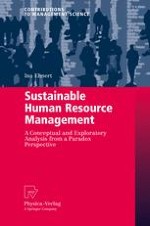2009 | Buch
Über dieses Buch
Predictions are that sustainability becomes the next big topic for Human Resource Management after internationalization and globalization. This book gives new answers to these questions: - How can HRM contribute to attracting, developing and retaining highly qualified human resources over time? - How can a paradox perspective contribute to understanding and coping with paradoxical tensions? - How can sustainability be used as a ‘deliberate strategy’ for HRM?
The conceptual part of the book looks at the notion of sustainability, opens it up for Strategic HRM and identifies blind spots in Strategic HRM theory. Paradox theory is introduced as an analytical framework for Sustainable HRM. Initial suggestions are made for sustainability strategies and for coping with paradoxes and tensions. The exploratory part examines how 50 European Multinationals communicate their understanding of sustainability and HRM and which HR issues and practices they are linking to the topic.
Anzeige
